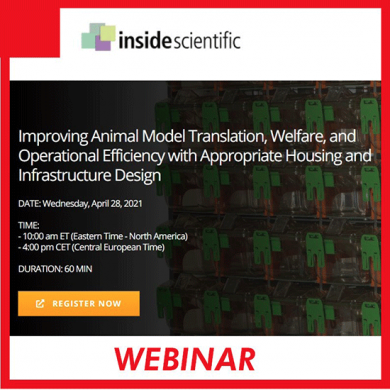
The current version of the Tecniplast website doesn't match your region. Please visit your local website to find information and offerings specific to your country.

The current version of the Tecniplast website doesn't match your region. Please visit your local website to find information and offerings specific to your country.


A real interesting Live Webinar on InsideScientitific Platform, titled “Improving Animal Model Translation, Welfare, and Operational Efficiency with Appropriate Housing and Infrastructure Design” will evaluate the latest innovations both from a scientific and an architectural point of view.
The live webinar date is: Wednesday, April 28, 2021, Time: 10:00 am ET | 4:00 pm CET.
2 experienced opinion leaders in each other's specialties, John Hasenau, DVM (Scientist) and Jeffrey Zynda, Architect, will consider practical options for housing and infrastructural designs to sustainably improve animal welfare, data reporting and reproducibility through the use of new technologies used by academia, pharma and CROs to acquire animal activity data.
They will also present examples of the practical application of digital information across a global organization and within a unit, and its effects on study reproducibility, on scientific results for PIs and on lab animal facility management.
Differences in cage components, housing density, cage changing frequency and best practices will all be considered in the context of animal model development, physiology and behavior. Key topics include:
To register to the webinar click on this link
John Haseanau
John has been involved in lab animal research for over 30 years in varied areas of research, academia, industry, and most recently consultancy. He has managed and directed veterinary programs at large pharmaceutical companies in preclinical drug discovery and toxicology safety groups (Abbott Laboratories and Baxter Healthcare), as well as at a large contract research organization (Charles River Laboratories).
He has also enjoyed teaching and research settings (Michigan State University, Ross University, University of Rochester, Northwestern University and most recently at University of Nevada, Reno where he retired). John is semi-retired, doing consulting work to help promote optimal Laboratory Animal Care and Welfare.
Jeffrey Zynda
Principal, Science and Technology Practice Leader at Perkins+Will. Jeff comes from a long line of craftsmen–builders, carpenters, and precision tool makers. His appreciation of craft and fascination for the juxtaposition of contemporary and traditional design carries through to his practice of architecture for science and technology. Jeff is driven to explore the intersection of high design and the highly technical. He strives to improve the perception of laboratories and research environments; he believes these spaces can be the height of humanistic design.
To achieve this, he gains an understanding of a lab’s user group by asking not what they need, but rather what they do, and then designing a response with them that is much more impactful and aspirational than just a “lab.” When Jeff and his team start a project, they establish goals with the client that serve as guiding principles throughout the process. Success for him is seeing that the goals were achieved, and that a facility is supercharging research.